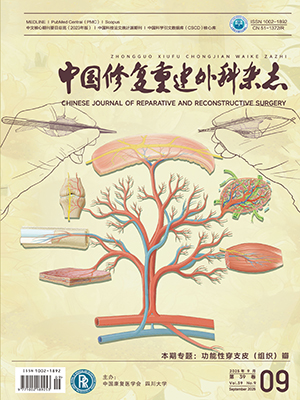Objective To investigate the method and the short term cl inical effectiveness of in situ suture repair procedure of knee dislocation with multi ple-l igament injury at acute stage. Methods From February 2006 to November 2007, 9 patients suffering from single knee closed dislocation with multi ple-ligament injury underwent open in situ suture repair
procedure with non-absorbable thread and managements of other combined injuries simultaneously. Nine patients included 6 males and 3 females, aged 34-52 years old. The injured knees were left side in 4 cases and right side in 5 cases. Injuries were caused by traffic accident in 8 cases and heavy-weight crushing in 1 case. EMRI and arthroscopic examination showed that all patients suffered from the avulsion injuries of anterior cruciate l igament and posterior cruciate l igament. The time from injury to operation was 4 to 7 days with an average of 5.1 days. Results No bacterial arthritis occurred after operation. Subcutaneous liquated fat occurred and cured after symptomatic treatment in 2 cases, other incisions healed by first intension. All patients were followed up 12 months. At 12 months postoperatively, 2 patients’ flexion range of the suffering knees lost 10° when to compared with normal knees, and the range of motion was from 0 to 125°. The Lysholm knee scores were 83-92 (average 86.3), the results were excellent in 3 cases and good in 6 cases. The posterior drawer test and anterior drawer test were one-degree positive in 3 cases respectively; the Lachman tests were one-degree positive in 5 cases, lateral stress tests were negative in all cases. Conclusion In situ suture repair procedure of knee dislocation with multi ple-ligament injury at acute stage has the advantages such as rel iable fixation, simultaneous management of other combined injuries and satisfactory short term effect.
Citation: YE Jingbing,LUO Dahui,FU Weili,HE Xin,LI Jian.. IN SITU SUTURE REPAIR PROCEDURE OF KNEE DISLOCATION WITH MULTIPLE-LIGAMENT INJURY AT ACUTE STAGE. Chinese Journal of Reparative and Reconstructive Surgery, 2009, 23(9): 1049-1052. doi: Copy
Copyright © the editorial department of Chinese Journal of Reparative and Reconstructive Surgery of West China Medical Publisher. All rights reserved




